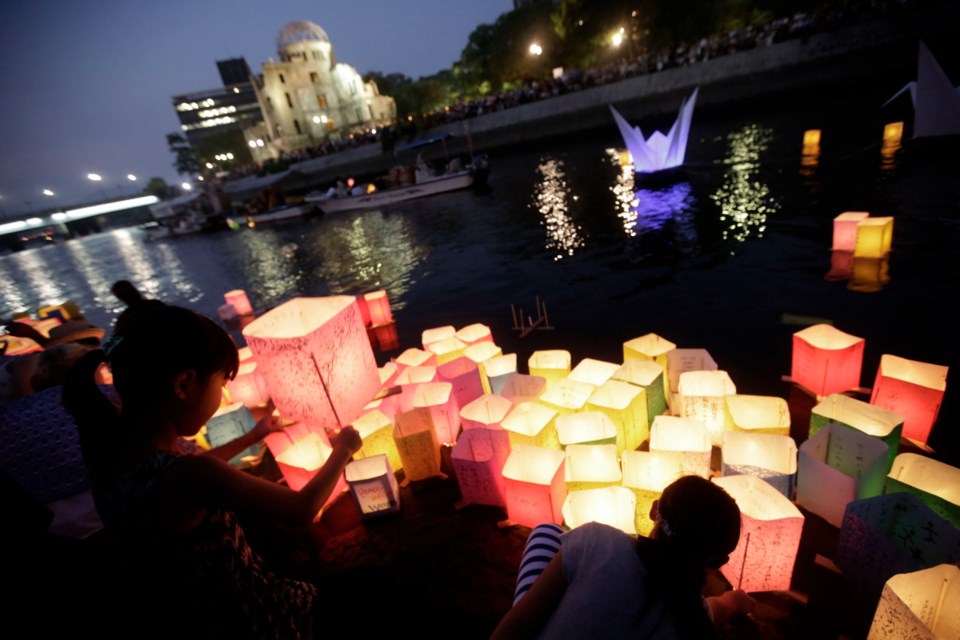At 8:15 a.m. on Aug. 6, 1945, an atomic bomb made from Canadian uranium was dropped on Hiroshima, a Japanese city of similar size to Victoria. At 11:02 a.m. on Aug. 9, 1945, a plutonium bomb with a much bigger explosive force was dropped on Nagasaki.
This was not the first use of a weapon of mass destruction. On April 22, 1915, poison gas was used for the first time at Ypres Salient, Belgium. It is there that the similarity between the two events ends.
The targets of the nuclear weapons were not soldiers crouching in their trenches. The targets were mothers and fathers, sons and daughters, grandmothers and grandfathers, aunts and uncles — regular people living in a country that was at war with us and our allies.
There was no real help available. Most of the doctors and nurses were dead. Forty-two of the 45 hospitals had been destroyed; ninety per cent of the buildings and infrastructure had been reduced to rubble. By the end of 1945, more than 210,000 people had died, and over the next 70 years, many more people continued to suffer and die from the effects of ionizing radiation.
On June 24, 1982, at the Second Special Session on Disarmament held at the United Nations, the mayors of Hiroshima and Nagasaki issued a joint call to their colleagues around the world. They invited municipal mayors to join them as “Mayors for Peace.” The idea was to promote solidarity of cities by working toward the total abolition of nuclear weapons. As of June 1, more than 6,700 cities and municipalities in 160 countries are members of Mayors for Peace. This represents one-seventh of the world’s population, or one billion people.
In January 2001, Victoria’s mayor Alan Lowe joined Mayors for Peace and in October 2013, Mayor Nils Jensen initiated his Oak Bay municipality’s membership.
Physicians for Global Survival is the Canadian affiliate of International Physicians for the Prevention of Nuclear War. IPPNW is a non-partisan federation of national medical groups in 64 countries, representing tens of thousands of doctors, medical students and other health workers working for the abolition of nuclear weapons.
In 1985, IPPNW was awarded the Nobel Peace Prize. As physicians, we know there is no medical response to a nuclear war. Whether by accident or by malicious intent, the explosion of just a small nuclear device would have catastrophic effects for which there is no humanitarian response.
After the fall of the Berlin Wall in 1989, the two major nuclear-weapon states started to reduce their respective nuclear arsenals. There was a sense at the time that the endgame could be the total elimination of nuclear weapons. Many activists moved on to other areas of concern, and the abolition of nuclear weapons fell off our collective radar.
We are a long way from that now. The Bulletin of Atomic Scientists recently moved the Doomsday Clock to three minutes before midnight — the closest it has been in 30 years. Trillions of dollars have been earmarked by the five major nuclear-weapon states for upgrades and modernization.
The 70th anniversary of the bombing of Hiroshima and Nagasaki is a good time for the other 11 mayors in the Capital Regional District to join the mayors of Victoria and Oak Bay as members of Mayors for Peace. This is an opportunity for all Canadian mayors to speak out and tell their provincial and federal counterparts that cities are not targets.
Physicians and other health-care workers must step up again, and demand a world free of nuclear weapons. There is no cure for this fatal disease and our only option is prevention. No other outcome is acceptable.
Javier Perez de Cuellar, former UN secretary-general said: “In a nuclear age, decisions affecting war and peace cannot be left to military strategists or even to governments. They are indeed the responsibility of every man and woman. And it is therefore the responsibility of all of us … to break the cycle of mistrust and insecurity and to respond to humanity’s yearning for peace.”
The 70th anniversary of Hiroshima and Nagasaki remembrance ceremony will be held at Esquimalt Gorge Park this evening at 7:30.
Jonathan Down is a board member of Physicians for Global Survival. Lisa Helps is the mayor of Victoria and Nils Jensen is the mayor of Oak Bay.



